Mirrors, mirrors on the Wall….Mud Relief

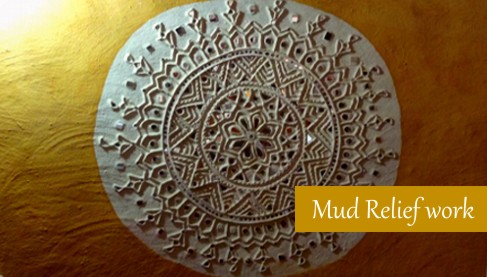
Among the remains of one of the most ancient civilizations, at the Indus Valley site at Dholavira, Gujarat, were pieces of earthen ware, surviving in their original form for five thousand years.
As per Hindu belief the human body is composed of five natural elements, one of them being earth, and we humans always like to be close to it. Children have loved playing with wet clay, whether in the present day or a few thousand years ago. Terracotta toys found in Harappan excavations show that the civilization was expert in mud related crafts, as the raw material was easily available all around.
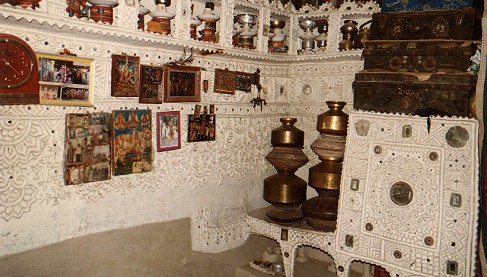
Mud relief work is one forte of village dwellers, which they use to decorate their houses. In the great Rann of Kutch, Gujarat, many hamlets have Mud relief walls with the motifs that usually represent their feelings and beliefs.
The mud is prepared with clay easily found in the Great Rann of Kutch. It is pounded and sifted through a sieve to get a smooth powder and other ingredients are added for anti cracking properties. These are thin fibers obtained from sieving donkey dung, which are then mixed with the mud and kneaded with water as per the requirement of the desired patterns. It is rolled on a plain surface by the palms, to get a string like form and then this string is fixed with pressure on water-wetted wall or wooden plaques to get the desired forms.The beauty of these artistic hands lies in the fact that they can make any motifs without any visual markings or drawings to facilitate mud relief work.

Mud relief work is done by different communities in Kachchh, and they have their own distinct styles.
Kachchhi Rabari Mud Relief Work: Kachchhi Rabari is the biggest sub tribe of Rabari community and their work is most excellent in its art form. Today it is on the verge of extinction as the younger generation is not interested in doing this art work. Rabari work is characterized by thick lines and less care is taken to prepare the cow dung and clay mixture. Hence it turns out to be very rough and rustic in look. Walls of house and items like storage chest, quilt-stand and grain-box are embellished with this art. Elephant, camel, peacock, parrot, scorpion, woman with water pots on her head, women churning butter milk, trees, flowering vines, hills, and temples are common motifs to be used with lots of mirrors in round, square, triangle shapes. The Rabaris believe that mirrors repel the negative effects of the evil eye and so they use them in mud relief work and embroidery.
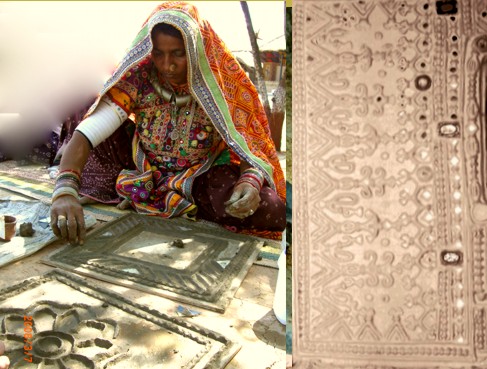
Harijan Mud Relief Work: Marvada Harijan of Banni area in the Great Rann of Kutch had played a vital role to popularize this art and had made efforts to establish this art in metro cities, as part of interior decoration on walls of drawing rooms and five stars Hotels. This art has been used to decorate stages for musical programmes and also to garnish song-settings in Hindi films. Hamlets of Banni area are full of this art, in every house one can see walls that are embellished with mud-relief work. Most of the designs and motifs are derived from their own embroidery and stitching designs, geometrical forms, pheasants; a woman with water pots is most auspicious sign for this community.
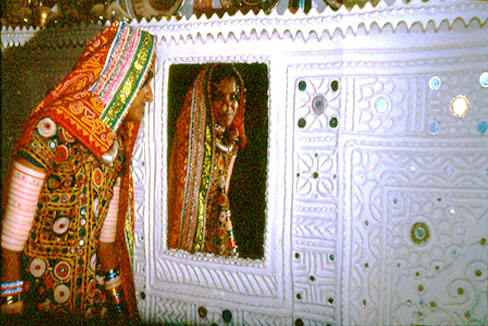
Mutwa Mud-Relief-Work: Being Islamic by religion Mutwa community’s mud-work has the essence of their recurring motifs. Women of this community are well known for their tiny embroidery stitches. But mud-relief-work is done by men only. Mr. Mehmood Mutwa is the master craftsman of this art and his own house is a museum of this art. Mutwa mud-relief-work is done with thin lines and geometrical Islamic forms, replica of their own ornaments and non-living forms. The motifs are carefully chosen in their work as Islam does not permit them drawing of living beings as motifs.
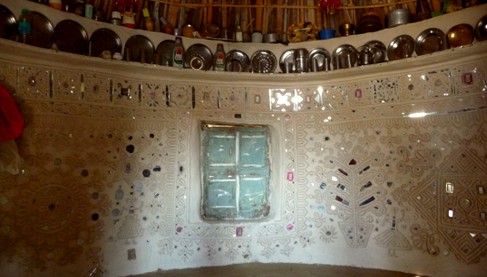
With the earthquake that hit Gujarat in January 2001, most of this area was destroyed; many mud houses shattered to ground losing most of the adorning art of ancient heritage.
While the application of mud relief work is decreasing in the villages, metropolitan cities are slowly recognizing the rustic charm of this sculptural craft.
Text by~
Shri Kantilal Doobal
Tourist Guide, Bhuj, Gujarat, India
Photographs by~
Shri Kantilal Doobal & Gaatha team










